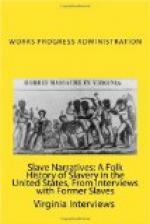Opinions of the Present
“I think times are about dead now. Things ought to get better. I believe things are going to get better for all of us. People have got to think more. People have got to get together more. War doesn’t always make thing better. It didn’t after the Civil War. And it didn’t after the World War. The young people are all right in their way. It would just take another war to learn ’em a lesson.
Support
“I can’t do any work now. I get a little help from the welfare. It doesn’t come regular. I need a check right now. I think it’s due now. But they haven’t sent it out yet. That is, I haven’t got it.
“I’m a Christian. All my family were Methodists. I belong to Wesley.
Interviewer: Mary D. Hudgins
Person Interviewed: Judy Parker
Home: 618 Wade Street, Hot Springs, Ark.
Aged: 77
For location of Wade Street, see interview with Emma Sanderson.
As the interviewer walked down Silver Street a saddle colored girl came out on a porch for a load of wood.
“I beg your pardon,” she began, pausing, “can you tell me where I will find Emma Sanderson?”
“I sure can.” The girl left the porch and came out to the street. “I’ll walk down with you and show you. That way it’ll be easier. Kind of cold, ain’t it?”
“It surely is,” this from the interviewer. “Isn’t it too cold for you, can’t you just tell me? I think I can find it.” The girl had expected to be only on the porch and didn’t have a coat.
“No, ma’am. It’s all right. Now we’re far enough for you to see. You see those two houses jam up against one and ’tother? Well Miz Parker lives in the one this way. I goes down to look after her most every day. That’s where you’ll find her.—No ma’am—’twaren’t no bother.”
The gate sagged slightly at the house “this way” of the “two jam up against one and ’tother.” A large slab from an oak log in the front yard near a woodpile bore mute evidence of many an ax blow. (Stove wood is generally split in the rural South—one end of the “stick” resting against the ground, the other atop a small log.)
Up a couple of rickety steps the interviewer climbed. She knocked three times. When she was bade to enter she opened the door to find an old woman sitting near a wood stove combing her long, white hair.
Mrs. Parker was expecting the visit. A few days before the interviewer had had a visit from a couple of colored women who had “heard tell how you is investigating the old people.—been trying to get on old age pension for a long time—glad you come to get us on.——No? Oh, I see you is the Townsend woman.” (An explanation of her true capacity was almost impossible for the interviewer.)
Mrs. Parker, however, seemed to comprehend the idea perfectly. She expected nothing save the chance to tell her story. Her joy at the gift of a quarter (the amount the interviewer set aside from her salary for each interviewee) was pitiful. Evidently it had been a long time since she had possessed a similar sum to spend exactly as she pleased.




